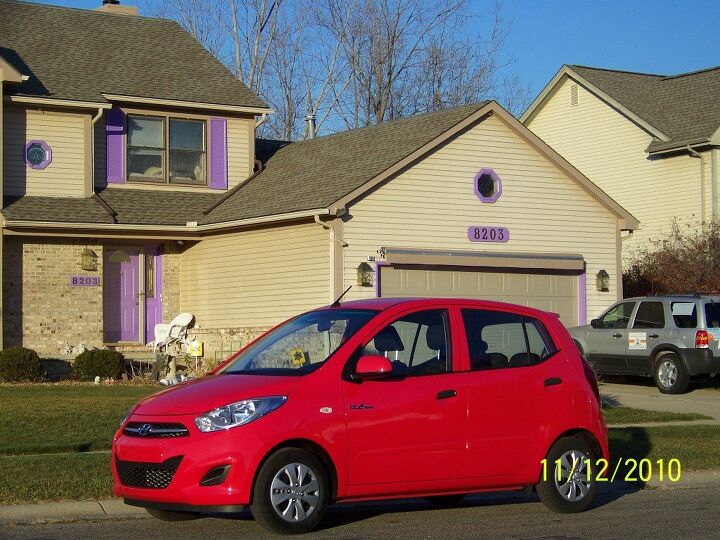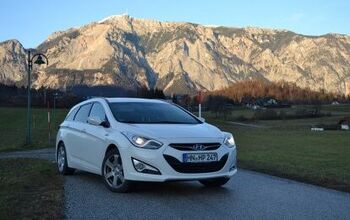Review: Hyundai I10
Hyundai seems fearless. Its venture above $30,000 with the Genesis wasn’t a rousing success, yet two short years later they’re doubling down with a $65,000 flagship. But there is one car they dare not offer here, from the opposite end of the line: the diminutive i10. So, what are we missing?
B-segment cars like the Fiesta, Fit, and Versa have been exploring the lower limits in the 21st-century American market. But once upon a time truly small cars like the Chevrolet Sprint and Ford Festiva were offered here. The i10’s 140-inch length (20 inches shorter than the Accent) and 63-inch width (3 inches narrower) put it within an inch of the Festiva. The i10’s 2,000-pound curb weight is a couple hundred above the Festiva’s, but modern NVH and safety standards have done much worse to a car. The biggest change from the city cars of yesteryear: the i10’s 61-inch height. The Festiva appeared disproportionately tall back in the day, but the i10 is a substantial half-foot taller.
Venture over to Hyundai’s UK website, and you’ll find a car that’s almost appealing from the side and rear quarter. But the freshened 2011 i10 (now with the new corporate hexagonal grille!) was brought to a U.S. media event to show off a new engine. So no one bothered to bless the tested car with a flattering shade of paint or stylish alloy wheels. With its monumentally tall bodysides, body-color pillars, and tiny wheels, the i10 can’t pull off bright red any more than a standard colonial house can pull off lavender trim. The hubcaps do the car no favors, either. So attired, the i10 screams “penalty box.”
The interior is a happier place, with fluid styling, red accents, and materials of decent quality. (Sure, the interior panels are all hard plastic, but what did you expect for a car that would list below $10,000 here?) The i10’s unusual height translates into seats mounted comfortably high off the floor and plentiful headroom. Because the seats are mounted high, and wheel wells sized for 14s don’t intrude, there’s sufficient legroom for adults in both rows despite the i10’s brief 94-inch wheelbase. It helps that, unlike in the Equus flagship, there’s plenty of room for the rear passengers’ feet beneath the front seats. The much lengthier Ford Fiesta and Mazda2 are considerably more cramped inside. Not that all is perfect within the i10: the rear seat is flat, thinly padded, and, like the third row in some SUVs, tops off a few inches short of shoulder height. Behind the rear seat there’s enough cargo space for the grocery store. Fold the rear seats and runs to CostCo aren’t out of the question. Given the space Hyundai’s engineers had to work with, they carved out a surprisingly functional interior. As Sir Alec demonstrated a half-century ago, it’s possible to provide a surprising amount of room inside a tiny car if the machine is kept to a minimum.
The numbers that excite potential i10 buyers emerge from the test lab, not the test track. The 2010 i10’s base engine, a 1.1-liter four, wasn’t competitive in terms of fuel economy or CO2 emissions. An upcoming 429-horsepower 5.0-liter V8 notwithstanding, Hyundai is intently focused on improving its green rep. So the company developed an all-new three-cylinder as part of its “kappa” engine family. Variable induction and variable valve timing on both cams wring 69 horsepower (at 6,200 rpm) and 69 foot-pounds of torque (at 3,500) out of 1.0 liter. And the key achievements: a 17 percent improvement in fuel efficiency (55 MPG in European testing) and CO2 emissions of 99 grams per kilometer (apparently nudging under 100 is a big deal across the pond). One trick: come to a stop, place the transmission into neutral, and release the clutch, and the engine shuts off. Depress the clutch, and the three automatically restarts.
Given the inherent imbalance of a three-cylinder engine, and the absence of inefficient balance shafts, I expected the kappa to feel rough. But, partly because the crankshaft is offset, it doesn’t. The engine does, however, produce an unseemly amount of noise when revved, discouraging runs to the redline. Given the modest power output—equivalent to 120 horsepower in a 3,500-pound sedan—acceleration is unsurprisingly tepid, though not unbearably so. For these seeking a little more power, a 79-horsepower 1.2-liter four is also offered. Still not enough? Hyundai plans to turbocharge both engines, with the turbo 1.2 slated to receive the additional benefit of direct injection.
If these engines are offered in the i10—they might be destined for larger cars—the resulting 110-140 horsepower would be…interesting. It’s not clear that the i10 could handle so much power. In the U.S. vehicle market, the nearly 1:1 ratio between the small Hyundai’s height and width is only approached by the clumsiest SUVs…and the smart fortwo. So the i10’s generous body roll in turns and tippy feel above 40 miles-per-hour also comes as no surprise. One size class up, the lower, wider Mazda2 handles far better. Approach highway speeds in the i10 and wind, road, and engine noise become intrusive—especially the first. This said, the i10 does ride smoother and feel far more solid than the Sprint and Festiva of yore. It doesn’t feel cheap, just sluggish and tippy.
Coors beer seemed special when you had to make an illegal high-speed run across multiple state lines to get it. Likewise, it’s always scintillating to drive a class of car we can’t get here. The A-segment Hyundai offers an impressive amount of interior space given its tiny footprint, and the new three-cylinder engine is smooth enough and perhaps even powerful enough for American consumption. But the i10’s handling and high (by current standards) noise levels render it a city car. Even in congested, tax-happy Europe such cars capture only 10 to 12 percent of the market. And, compared to the next Accent, the i10’s exterior appearance is downright dorky, projecting the very image Hyundai has been striving to bury. So, unless gas prices surge well over $4 a gallon, and perhaps not even then, the i10 won’t be threatening the dignity of the Equus inside U.S. showrooms.
Hyundai made this vehicle available at a ride-and-drive event.
Michael Karesh owns and operates TrueDelta, an online source of automotive reliability and pricing data
Michael Karesh lives in West Bloomfield, Michigan, with his wife and three children. In 2003 he received a Ph.D. from the University of Chicago. While in Chicago he worked at the National Opinion Research Center, a leader in the field of survey research. For his doctoral thesis, he spent a year-and-a-half inside an automaker studying how and how well it understood consumers when developing new products. While pursuing the degree he taught consumer behavior and product development at Oakland University. Since 1999, he has contributed auto reviews to Epinions, where he is currently one of two people in charge of the autos section. Since earning the degree he has continued to care for his children (school, gymnastics, tae-kwan-do...) and write reviews for Epinions and, more recently, The Truth About Cars while developing TrueDelta, a vehicle reliability and price comparison site.
More by Michael Karesh
Latest Car Reviews
Read moreLatest Product Reviews
Read moreRecent Comments
- Lou_BC I don't like black. I wouldn't want white because that's your standard fleet colour. I lean towards colour's that are less likely to show scratches and dings. The blue on my ZR2 is nice colour but a bad colour for showing up trail rash and dust. It wasn't my 1st choice but at the time it was the only truck I could find at a price I was willing to pay.
- Michael I don’t have the luxury of choosing the color of my car and even people in my life who have recently purchased relatively expensive new cars are having their choice of what local dealers have or what they’re getting in soon, shades of grey and white. If I had the choice I would have gone with color when I was younger but now would choose a silver, grey, or black. Whatever looked best on the model.
- CoastieLenn That price seems a bit high for a high mileage mid-tier Accord, especially a coupe whose resale is typically lower than the stalwart sedan. I do like this generation coupe a lot though.
- La3541 Red is my go-to color. I love candy-apple red (guards red on Porsche). I have had several red cars. Maroon is not good though.I have always loved British racing green and recently got my first one. A British racing green 4-series that I had to special-order.Silver, black, gray, and white are pretty boring. However, as RNA656.. stated, white looks good on some cars. for more boring colors, I also like chalk on porsches. Nardo gray on Audis is pretty nice.
- CoastieLenn They're gonna sell tens of these, and I don't believe those presented numbers for a second! Good on them for offering it though.








































Comments
Join the conversation
College campuses will be awash in these things.
I believe with $4/gallon gas, these would sell in the US. A few more HP and decent handling would go a long way. It looks good for it's size.